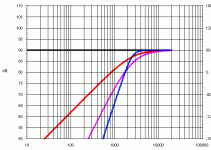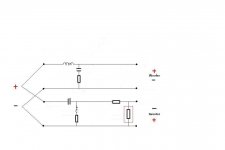Third order high pass is often used on tweeters to keep them out of trouble. But you should probably just go with L-R at this point. You may even move the crossover point up a bit, if you think the woofer can go that high.
Also, if you are building your own, don't be afraid to spread the frequencies some. ~20% is a good start. For Example: 2300Hz low pass, 2700Hz HP. Because of the physical separation of the drivers, this often sums better.
The chart below will give you an idea of three different filter types at your 2500Hz high pass point.
Red = 1st order Butterworth Pink = 2nd order L-R, Blue = 3rd order Butterworth.
You may see from this how the L-R filter may actually protect you tweeter the best. And also see why you could still hear 700Hz with the first order.
Also, if you are building your own, don't be afraid to spread the frequencies some. ~20% is a good start. For Example: 2300Hz low pass, 2700Hz HP. Because of the physical separation of the drivers, this often sums better.
The chart below will give you an idea of three different filter types at your 2500Hz high pass point.
Red = 1st order Butterworth Pink = 2nd order L-R, Blue = 3rd order Butterworth.
You may see from this how the L-R filter may actually protect you tweeter the best. And also see why you could still hear 700Hz with the first order.
Attachments
better listen to Cal and Pano, anything else will even harder to handle
and dont be afraid to deviate a bit from textbook calculation
but that takes some practice
and some knowledge about how components work, what they do
ask the right questions, and you might get some of it answered
one way to learn a lot is by looking at lots published speaker designs using 12db xo
study component values, xo points etc,
one main player is impedance
not the specced nominal, but actual one, and its variation
compare it with each drivers seperate frequency response, without filter
and dont be afraid to deviate a bit from textbook calculation
but that takes some practice
and some knowledge about how components work, what they do
ask the right questions, and you might get some of it answered
one way to learn a lot is by looking at lots published speaker designs using 12db xo
study component values, xo points etc,
one main player is impedance
not the specced nominal, but actual one, and its variation
compare it with each drivers seperate frequency response, without filter
Okay there's some things to think about there. First what's Cal and Pano? I understand what you are syaing about the deviation from the calculators numbersfor instance for the low pass filter for the woofer the impedence at 3KHz, the point I wish to filter it, is 20ohm so do I use this figure to work out the crossover point?
HERES the respnse curve.
Boscoe
HERES the respnse curve.
Boscoe
Can some double check my crossover plans please?
So after my previous thread and diagosing the problem with my tweeter as a fault with the crossover I am going to build a new one, a 2nd order linkwitz-riley. I am using THIS woofer and THIS tweeter I am going to filter the woofer at 2500Hz and the tweeter at 2000Hz. Right because of the impendence of the woofer at 2.5KHz which is 20ohm I assume this is the resistance I use in the crossover calculator and then the tweeter is just at 8ohm at 2KHz so that's easy!
I assumed this from the stuff from my toher thread I just want to check it before I order the components.
Thanks
Boscoe
So after my previous thread and diagosing the problem with my tweeter as a fault with the crossover I am going to build a new one, a 2nd order linkwitz-riley. I am using THIS woofer and THIS tweeter I am going to filter the woofer at 2500Hz and the tweeter at 2000Hz. Right because of the impendence of the woofer at 2.5KHz which is 20ohm I assume this is the resistance I use in the crossover calculator and then the tweeter is just at 8ohm at 2KHz so that's easy!
I assumed this from the stuff from my toher thread I just want to check it before I order the components.
Thanks
Boscoe
From the plot you linked to, I'd say that you should use about 1.8mH + 4uF for your low pass. That gets you pretty close to a Linkwitz-Riley end order @ 2300Hz. Only 2 parts, cap and coil.
1.5mH and 3.5uF will get you close to 3KHz, but that's pushing the driver pretty far.
Do you have tweeter specs?
1.5mH and 3.5uF will get you close to 3KHz, but that's pushing the driver pretty far.
Do you have tweeter specs?
Long story condensed into a too-short answer, I'd say you need a Zobel network across the woofer. This "network" would be a capacitor in series with an 8-ohm resistor - the cap would have a reactance less than 8 ohms at the crossover frequency. This makes the woofer look like an 8 ohm impedance to the crossover, at and above the crossover frequency.
And these are just the basic fundamentals of good crossover design...
And these are just the basic fundamentals of good crossover design...
this one ?
hmm, that small peak above 3khz might be worse than it appears
MONACOR INTERNATIONAL:New products
maybe try to calculate woofer series inductor to set in at around 1200-1500hz
and just the zobel with cap anywhere between 4.7uf to 12uf, and the resistor 4R7 to 12R0, maybe
adjustment needed
tweeter series cap usually from 4.7uf to 6.8uf
paralel inductor usually close to 0.3mH, +/-
you may try a small series resistor on that one
all depending
and you need attenuation resistor on tweeter
I think you should try series resistor only, and adjust it
and just the zobel with cap anywhere between 4.7uf to 12uf, and the resistor 4R7 to 12R0, maybe
adjustment needed
tweeter series cap usually from 4.7uf to 6.8uf
paralel inductor usually close to 0.3mH, +/-
you may try a small series resistor on that one
all depending
and you need attenuation resistor on tweeter
I think you should try series resistor only, and adjust it
I don't mean to see elitist, but pretty horse-and-buggy not to just buy a Behringer CX3400 electronic crossover for $150 and some second hand amps. That's it.
An awful lot of Black Magic goes into those low-level crossovers (assuming somebody is bravely trying to make a 2-way system sound passable). Virtually impossible to duplicate that art at home let alone get the components to match adequately once they are chosen. And then no simple way to adjust ANYTHING. Feh.
But with the Behringer, you can twiddle the knobs and get anything you want, by way of curve control, loudness for each unit, mixed sub-woofer output, etc.
Maybe I am not so good with my old abacus, but I've never found "theory" to be within 20% of reality.
An awful lot of Black Magic goes into those low-level crossovers (assuming somebody is bravely trying to make a 2-way system sound passable). Virtually impossible to duplicate that art at home let alone get the components to match adequately once they are chosen. And then no simple way to adjust ANYTHING. Feh.
But with the Behringer, you can twiddle the knobs and get anything you want, by way of curve control, loudness for each unit, mixed sub-woofer output, etc.
Maybe I am not so good with my old abacus, but I've never found "theory" to be within 20% of reality.
Last edited:
Designing great passive crossover takes a lot of experience and time. But I don't know that "great" is called for here. We can certainly come up with something better than Boscoe now has and should work just fine. He might even learn something in the process. 
Active crossovers are cool, I use them. But for a simple 2-way box? I wouldn't bother.
Active crossovers are cool, I use them. But for a simple 2-way box? I wouldn't bother.
- Status
- This old topic is closed. If you want to reopen this topic, contact a moderator using the "Report Post" button.
- Home
- Loudspeakers
- Multi-Way
- Tweeter distorting due to woofer roll off I think.

